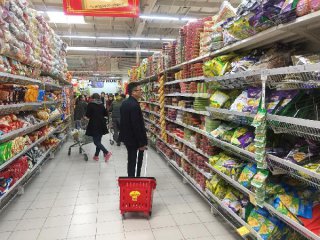
Consumption has made a good beginning during the China’s Lunar New Year holiday. Data of the Ministry of Commerce (MOFCOMM) issued on Feb. 2 shows that during the golden week of the Spring Festival, consumption has hit new high. From the Lunar New Year’s Eve to the sixth day of the first month of the Lunar New Year (Jan. 27 to Feb. 2), sales of the retail and food& beverage enterprises hit about 840 billion yuan, up by 11.4 percent compared with the same period last year.
But where has the money spent? Journalist of the Economic Information Daily learnt from the data of the MOFCOMM and the National Tourism Administration (NTA) that consumption in the tourism and food& beverage sectors are undoubtedly the main components. High quality consumption is a highlight.
“Our family has spent the Lunar New Year holiday in Thailand, and we found that shopping malls in Thailand also run advertising campaigns to celebrate the Chinese New Year. They also provided special purchases for the Spring Festival to target Chinese tourists who spent the Lunar New Year holiday in Thailand,” Ms Liu, who choose to spent the holiday in Thailand, told journalist from the Economic Information Daily.
In fact, the Spring Festival gradually becomes a golden week for overseas travelling. The “National Tour Group Service Management System” shows that about 6.15 million Chinese has travelled abroad during the Spring Festival, increasing by 7 percent year on year. 374,000 people joined package tour, up by 2.5 percent year on year. Data released by the Immigration Department of Hong Kong shows that 697,000 Mainland Chinese have visited Hong Kong during the holiday, rising by 3.7 percent year on year. Stats released by the Macau Government Tourist Office shows that 533,000 Mainland Chinese have visited Macau during the holiday, up by 8.5 percent year on year.
The arrival of Chinese visitors during the Lunar New Year holiday has given rise to the peak season of consumption overseas. Many overseas shopping malls offered discounts for Chinese visitors.
Ctrip.com estimated that Chinese tourists have departed for 174 destinations during the holiday, staying for an average duration of 9 days and in total spent over 14 billion U.S. dollars.
In addition to outbound tourism market, China’s domestic consumption also boomed during the holiday. The data center of the NTA calculates that China has received 344 million person-times during the holiday, up by 13.8 percent year on year. The total tourist income reached 423.3 billion yuan, up by 15.9 percent year on year.
Besides travelling, seeing film, watching drama, experiencing folk-custom, visiting the temple and playing snow and ice also become popular choices for Chinese people. The box office for the four days before the Lunar New Year hit 2.4 billion yuan, with that on the first day of the Lunar New Year hit record high for a single day. Tickets for the National Centre for the Performing Arts, China children's Art Theatre and Shanghai Dramatic Arts Center are in short supply.
As to catering consumption, family reunion dinner and dinner party are the main consumption areas during the holiday. Family reunion dinners at time-honored restaurants such as Quanjude, Bianyifang and Go Believe are fully reserved. During the holiday, operating revenue of monitored catering enterprises in Anhui Province, Yunnan Province and Xinjiang Uyghur Autonomous Region increased by 29.5 percent, 22.3 percent and 19.3 percent year on year.
As to goods consumption, monitoring data of the MOFCOMM shows that traditional special purchases for the Spring Festival, green food, seasonal apparels, gold and silver jewelries, intelligent and energy-saving home appliances and new digital products were best sellers. Healthy diets promote the sales of local specialties, seasonal fruits and health care gifts.
It is noteworthy that Chinese consumers’ consumption patterns are changing quietly. New highlights of consumption appeared during the holiday, especially high quality consumption and “Internet Plus”, which drives the consumption demand. During the Spring Festival, online shopping for special purchases for the Spring Festival, online restaurant reservation integrated with offline consumption; personalized and sharing consumption such as customized tourism and car sharing for home returning became popular. Consumption during the Spring Festival emphasizes more on the quality, health, fashion and individuality.
The trend of quality consumption upgrading could be seen from the subdivision of online shopping for food. Amazon China recently issued the annual “eating and drinking white paper”, which shows that China’s consumers pay greater attention to nutrition and quality in the selection of food, and emphasize balanced diet; as to fresh food, high quality import meat and seafood are new favorites on Chinese people’s dinner table; sales of import wine continued to rise, and to serve wine with Chinese food becomes a new trend at the dinner party during the holidays.
“Internet Plus” leads the fashion of catering consumption. Online restaurant reservation provides customized choice for consumers. Cross-border online shopping also becomes the choice of many consumers. The latest cross-border online shopping report issued by Amazon indicates that family as a unit has become the dominant group of cross-border online shopping. The development from individuals to households is also one of the key factors contributing to the diversification of online cross-border shopping and its closer ties with the daily life. Online cross-border shopping has already become a new normal in Chinese people’s lives.
In fact, the highlights of consumption during the Spring Festival reflect the change of China’s overall consumption structure. Industry insider pointed out that the flourish of green consumption, travel and leisure consumption and individualized consumption and new consumption pattern characterized by “Internet Plus” has thoroughly changed traditional consumption behavior and consumption model to become new drives of China’s consumption growth.
“Highlights of the consumption structure in 2017 are estimated to be as the following: first, hotspots of quality consumption are likely to continue. As consumers become less sensitive to prices, they pay greater attention to the cost performance of commodities, and pursue for high quality life. Customers’ demand for well-known brand and high-quality products increased, which is an important indicator of consumption upgrading. Secondly, individualized and diversified consumption demands standout. Besides, service consumption will also become an important pillar supporting consumption upgrading.
Service consumption and medium-high end consumption will also obtain major policy support. Journalist from the Economic Information Daily learnt from the MOFCOMM that to follow the trend of consumption structure upgrading and change in demand, expanding consumption for medium-high end product consumption and satisfy growing demand for emerging service consumption are important measures to release domestic consumption potential. Specifically, it includes carrying out a new round of comprehensive reform pilots in the service industry, formulating and implementing the outline for the innovative development of service economy, expanding duty free consumption to attract backflow of consumption from overseas, and launching a series of new measures to promote consumption.
Translated by Adam
























Latest comments